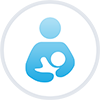The breastfeeding journey
Feeding | | HiPP Organic
Breastfeeding may be natural, but it's not always easy. Whether you're a first-time mum or an experienced one, getting the perfect latch can make all the difference to your breastfeeding journey. That's why we've put together this ultimate guide to help you learn the tips and tricks for achieving a great breastfeed every time. From common mistakes to solutions and helpful techniques, read on to discover everything you need to know about breastfeeding for a comfortable and successful experience.
Introduction to breastfeeding
Breastfeeding is one of the most natural and beneficial things you can do for your baby. It provides them with essential nutrients and antibodies that help protect them from infection.
However, it can also be challenging for both mums and babies. Many new mothers worry about whether or not they are doing it right and whether their baby is getting enough milk. Here are some tips and tricks for getting the perfect latch.
Benefits of breastfeeding
Breastfeeding has countless benefits for both mother and child. For the mother, it helps to shrink the uterus back to its normal size, can help with weight loss postpartum, and can provide much-needed bonding time with baby. Breastfeeding also lowers the risk of breast and ovarian cancer later in life. As for baby, breastfeeding provides them with immunity-boosting antibodies, reduces the chance of your baby getting an infection, can lower the risk of obesity and diabetes and sudden infant death syndrome (SIDS).
Understanding the latch
In order to ensure a successful and positive breastfeeding experience for both you and your baby, it is important to understand how the latch works. The latch is the connection between your baby's mouth and your breast. A good latch is key to preventing pain while breastfeeding, as well as ensuring that your baby gets enough milk.
To achieve a good latch, your baby should take as much of the areola (the darker area of skin around the nipple) into their mouth as possible, avoiding letting your baby suck on your nipple.
Once you have achieved a good latch, you will know it! There should be minimal pain and your baby should be able to stay on the breast without slipping off. If you are experiencing pain or your baby keeps slipping off, try repositioning them or using a different hold.
Once your baby is latched on, ensure that they have a good seal by checking that their lips are flanged outwards. You should also be able to hear them suckling rhythmically.
Common issues with breastfeeding
There are a few common issues that can arise when breastfeeding, but fortunately, there are also solutions for each one. You may need to get specialist help as this list isn't exhaustive and nothing beats in-person support. Here are some of the most common breastfeeding problems and how to fix them:
- Baby isn't latching on correctly - If your baby isn't latching on correctly, it can be painful for you and difficult for your baby to get enough milk. Make sure baby's chin is touching your breast, with the nose in line with the nipple. You can also try using a nipple shield to help continue breastfeeding if your nipples have become sore or cracked.
- Baby is not gaining weight -– Babies often lose weight in the first few days after birth – typically less than 10%. Your midwife will weigh your baby to make sure they’re regaining this weight. Most babies return to or exceed their birth weight within the first two weeks. If your baby hasn’t regained their birth weight, or isn’t regaining it quickly enough, your midwife will be able to help you identify the problem and find a solution.
- Engorgement - Engorgement happens when your breasts become overly full of milk. This can happen when you first start breastfeeding, as your milk is 'coming in', or if you miss a feed. To relieve engorgement, use a warm compress on your breasts or expressing some milk before feeding. This can also help to get your baby latched on well as the breast will be softer when it isn't so full.
- Cracked nipples - Cracked nipples can be painful and make it difficult to breastfeed. To heal cracked nipples, you can use your own breastmilk or specific cream and make sure you're using a good nursing bra that provides support but isn't too tight. You may also want to avoid using soap or other lotions on your nipples while they're healing.
Tips and tricks for getting the perfect latch
Breastfeeding can be a bit of a learning curve for both of you, but with a little patience and practice, you'll get the hang of it in no time. Here are some tips and tricks for getting the perfect latch:
- Start by positioning your baby's head close to your breast, with their chin touching your breast and their nose to your nipple.
- Ensure you and your baby are comfortable and in a position you're able to sustain. Feel free to kick out any visitors if you need to.
- Once their mouth is open wide, aim to get as much of your nipple and areola into their mouth as possible. You may need to hold them close to support them as they take a mouthful! You should hear them start to suckle at this point.
- If you experience any persistent pain or discomfort ensure you re-assess and re-latch. Do this as many time as you need to. It's important!
- To break the latch, simply insert your (clean) finger into the corner of your baby's mouth and they will release automatically.
Combination feeding
Although breastfeeding provides optimal nutrition for your baby, there are times when it’s not possible or practical. If you can’t breastfeed, or you need to supplement your breastmilk with formula, you’re not a bad mother. You’re doing what’s best for your family, and that’s all that matters.
There are two ways to combine breastfeeding and formula feeding: combination feeding and pumping & bottle feeding.
Combination feeding: With combination feeding, you breastfeed your baby some of the time and supplement with formula at other times. This is a good option if you don’t want to commit to exclusively breastfeeding or pumping and bottlefeeding.
Pumping and bottlefeeding: With this method, you pump breastmilk and feed it to your baby from a bottle. This is a good option if you want to continue breastfeeding but need to be away from your baby or supplement with formula occasionally.
Breastfeeding can be a beautiful and rewarding experience - once you've got the hang of it. Achieving the perfect latch is essential to ensure that your baby gets plenty of nutrition while minimising discomfort for you. Getting the perfect latch takes practice, patience, and persistence. Remember to seek in- person support if you're unsure, in pain or have any concerns. Your midwife and health visitor are always happy to help.


